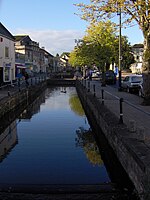Huish Colliery Quarry
English Site of Special Scientific Interest stubsQuarries in SomersetRadstockSites of Special Scientific Interest in AvonSites of Special Scientific Interest notified in 1985 ... and 2 more
Somerset geography stubsUse British English from February 2023
Huish Colliery Quarry (grid reference ST695542) is a 0.8 hectare geological Site of Special Scientific Interest near the town of Radstock, Bath and North East Somerset, notified in 1985. This site includes rocks from the Lower Jurassic period many of which were removed by erosion leading to discontinuations in the Lias. The whole of the Sinemurian Stage and virtually all of the Hettangian Stage is absent. Also notable is the fact that the Jamesoni Zone limestones, which occur here, are much thicker and better developed than at any other comparable sites in the Mendip Hills.
Excerpt from the Wikipedia article Huish Colliery Quarry (License: CC BY-SA 3.0, Authors).Huish Colliery Quarry
Nelson Ward Drive,
Geographical coordinates (GPS) Address Nearby Places Show on map
Geographical coordinates (GPS)
| Latitude | Longitude |
|---|---|
| N 51.28611 ° | E -2.43873 ° |
Address
Radstock Southfield
Nelson Ward Drive
BA3 3FS , Southfield
England, United Kingdom
Open on Google Maps








